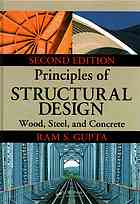(Ebook) Principles of Structural Design: Wood, Steel, and Concrete by Gupta, Ram S ISBN 9781466552319, 146655231X
"Anyone involved with structural design must maintain a functional understanding of wood, steel, and concrete design principles. Covering all of these materials, this book provides a self-contained authoritative source that elaborates on the most recent practices together with the code-connected fundamentals that other books often take for granted. Organized for ready reference, the text presents the LRFD approach for designing structural elements according to the latest codes. Written primarily for architecture and construction management students, it is equally suitable for those in civil and structural engineering programs"--"Preface There is a need for an elementary level textbook in structural design that this book aspires to fill in. The book has a code-connected focus. Since publication of the first edition in 2010, all codes and standards have undergone revisions. The International Building Codes and the International Residential Codes are enhanced to year 2012. The American Society of Civil Engineers (ASCE) has revised the Minimum Design Loads for Buildings and Other Structures to ASCE 7-10. The American Wood Council has published National Design Specifications (NDS) 2012 for wood design. The American Institute of Steel Construction (AISC) has updated the Steel Construction Manual and the Seismic Design Manual to 2010 Standards and Specifications. The American Concrete Institute (ACI) has come up with new ACI 380-2011 Building Code Requirements for Structural Concrete. All these have necessitated the revision of the book in a quick succession. While undertaking this task, the text material has been thoroughly reviewed and expanded, including inclusion of a new chapter on concrete design. The book retains its original feature; it is suitable for a complete design coursework in wood, steel, and concrete. It is a self-contained book that includes all essential section properties, design values, reference tables, and other design aids needed to perform a complete structural design. Unlike other books, the requirements of the codes and standards of the issuing agencies are not a prerequisite with this book. The book is appropriate for a program in architecture, construction management, general engineering, and civil engineering where the curriculum provides a joint coursework in wood, steel, and concrete design. The book is divided into four sections, expanded into 17 chapters"-- Abstract: "Anyone involved with structural design must maintain a functional understanding of wood, steel, and concrete design principles. Covering all of these materials, this book provides a self-contained authoritative source that elaborates on the most recent practices together with the code-connected fundamentals that other books often take for granted. Organized for ready reference, the text presents the LRFD approach for designing structural elements according to the latest codes. Written primarily for architecture and construction management students, it is equally suitable for those in civil and structural engineering programs"--"Preface There is a need for an elementary level textbook in structural design that this book aspires to fill in. The book has a code-connected focus. Since publication of the first edition in 2010, all codes and standards have undergone revisions. The International Building Codes and the International Residential Codes are enhanced to year 2012. The American Society of Civil Engineers (ASCE) has revised the Minimum Design Loads for Buildings and Other Structures to ASCE 7-10. The American Wood Council has published National Design Specifications (NDS) 2012 for wood design. The American Institute of Steel Construction (AISC) has updated the Steel Construction Manual and the Seismic Design Manual to 2010 Standards and Specifications. The American Concrete Institute (ACI) has come up with new ACI 380-2011 Building Code Requirements for Structural Concrete. All these have necessitated the revision of the book in a quick succession. While undertaking this task, the text material has been thoroughly reviewed and expanded, including inclusion of a new chapter on concrete design. The book retains its original feature; it is suitable for a complete design coursework in wood, steel, and concrete. It is a self-contained book that includes all essential section properties, design values, reference tables, and other design aids needed to perform a complete structural design. Unlike other books, the requirements of the codes and standards of the issuing agencies are not a prerequisite with this book. The book is appropriate for a program in architecture, construction management, general engineering, and civil engineering where the curriculum provides a joint coursework in wood, steel, and concrete design. The book is divided into four sections, expanded into 17 chapters"
*Free conversion of into popular formats such as PDF, DOCX, DOC, AZW, EPUB, and MOBI after payment.


